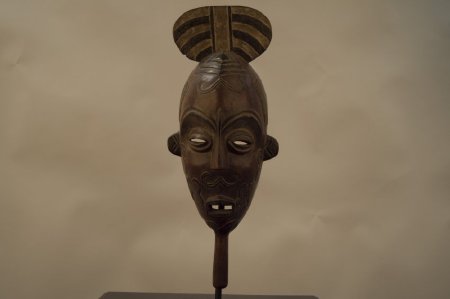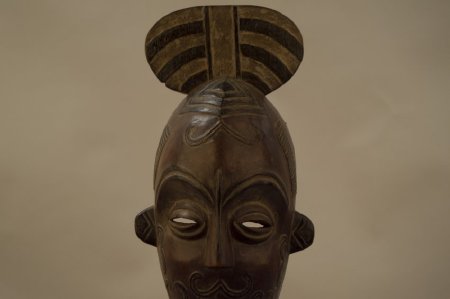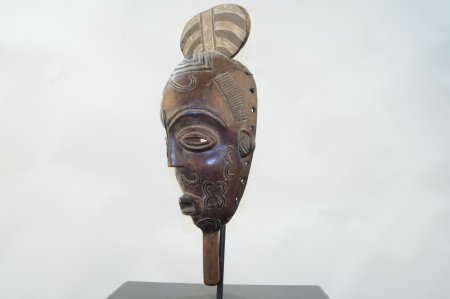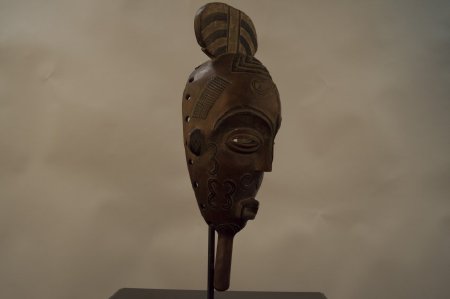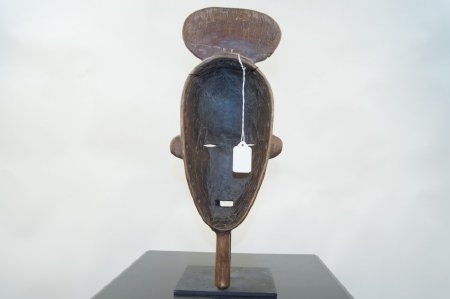Title:
Bena Lulua Style Mask
Object Name:
Mask, Ritual, Bena Lulua
Other Name:
Mask, Dance, (Luluwa)
Place of Origin:
Bena Lulua, Democratic Republic of Congo, Africa
Provenance:
Aboriginal Indigenous Art.
H = 16—1/2"
W = 7"
D = 6"
Lulua is an umbrella term, which refers to a large number of heterogeneous peoples who populate the region near the Lulua River, between the Kasai and Sankuru rivers. The Lulua people migrated from western Africa during the 18th century and settled in the southern part of the Democratic Republic of the Congo (formerly Zaire).
The heterogeneous composition of the people and the considerable area they occupy, explain the many stylistic overlappings with their neighbors. The formal and functional diversity of the masks testifies to the region as an ethnic crossroads and sometimes makes it difficult to confirm their origin. One can distinguish at least two categories of wooden Lulua masks. The first group consists of face masks with concave eye—sockets and intricate geometric painted patterns; the second consists of face masks with concave eye—sockets, simpler patterns, and plank—shaped crest. Lulua masks with their pointed nose and deep eye—sockets were probably used during circumcision and funeral ceremonies.
The Lulua considered them self to be Luba, a Pemba subgroup. The name Lulua was given to the Bena Moyo who lived on the banks of the Lulua River in Zaire by explorers in 1881. During the late 19th century, Lulua culture underwent drastic changes. In 1875 Lulua king Kalabam sanctioned new social and religious policies. He ended palm wine drinking, hemp smoking and had all cult carvings incinerated. In 1888 the use of scarification was banned. The impact on Lulua tradition was great. The Lulua were infamous for applying highly stylized incised scarification markings and patterns onto themselves and all related artwork. To them scarification signifies individuality and life itself.
H = 16—1/2"
W = 7"
D = 6"
Lulua is an umbrella term, which refers to a large number of heterogeneous peoples who populate the region near the Lulua River, between the Kasai and Sankuru rivers. The Lulua people migrated from western Africa during the 18th century and settled in the southern part of the Democratic Republic of the Congo (formerly Zaire).
The heterogeneous composition of the people and the considerable area they occupy, explain the many stylistic overlappings with their neighbors. The formal and functional diversity of the masks testifies to the region as an ethnic crossroads and sometimes makes it difficult to confirm their origin. One can distinguish at least two categories of wooden Lulua masks. The first group consists of face masks with concave eye—sockets and intricate geometric painted patterns; the second consists of face masks with concave eye—sockets, simpler patterns, and plank—shaped crest. Lulua masks with their pointed nose and deep eye—sockets were probably used during circumcision and funeral ceremonies.
The Lulua considered them self to be Luba, a Pemba subgroup. The name Lulua was given to the Bena Moyo who lived on the banks of the Lulua River in Zaire by explorers in 1881. During the late 19th century, Lulua culture underwent drastic changes. In 1875 Lulua king Kalabam sanctioned new social and religious policies. He ended palm wine drinking, hemp smoking and had all cult carvings incinerated. In 1888 the use of scarification was banned. The impact on Lulua tradition was great. The Lulua were infamous for applying highly stylized incised scarification markings and patterns onto themselves and all related artwork. To them scarification signifies individuality and life itself.
Description:
Oval—shaped wooden face mask, with protruding slit eyes in large concave orbits. Rectangular—shaped protruding pierced mouth. Rectangular—shaped nose, leading into large prominent crescent—shaped eyebrows. Scarification mark running up center of nose to central forehead area. Nine double crescent—shaped scarification marks on facial area, right and left cheeks, chin, forehead and upper lip. Small half circle—shaped ears, with two triangular scarification marks on each. Rectangular box of horizontal scarification grooves running down either side of top back forehead area. Four triangular layered scarification marks on top center of forehead, below large oval—shaped coiffure, with vertical and horizontal lines carved and painted, alternating between dark brown vs. tan, paint or patina. Long thin circular handle, starting at bottom of chin. Entire surface area covered with dark brown patina.
Collection:
Guy Mace Collection, (Turblex Company)
Material:
Wood W/Paint or Patina
Used:
Ritually Used
Technique:
Carving / Painting
Owned:
Art Department, MSSU
Accession#:
2015.2.27
